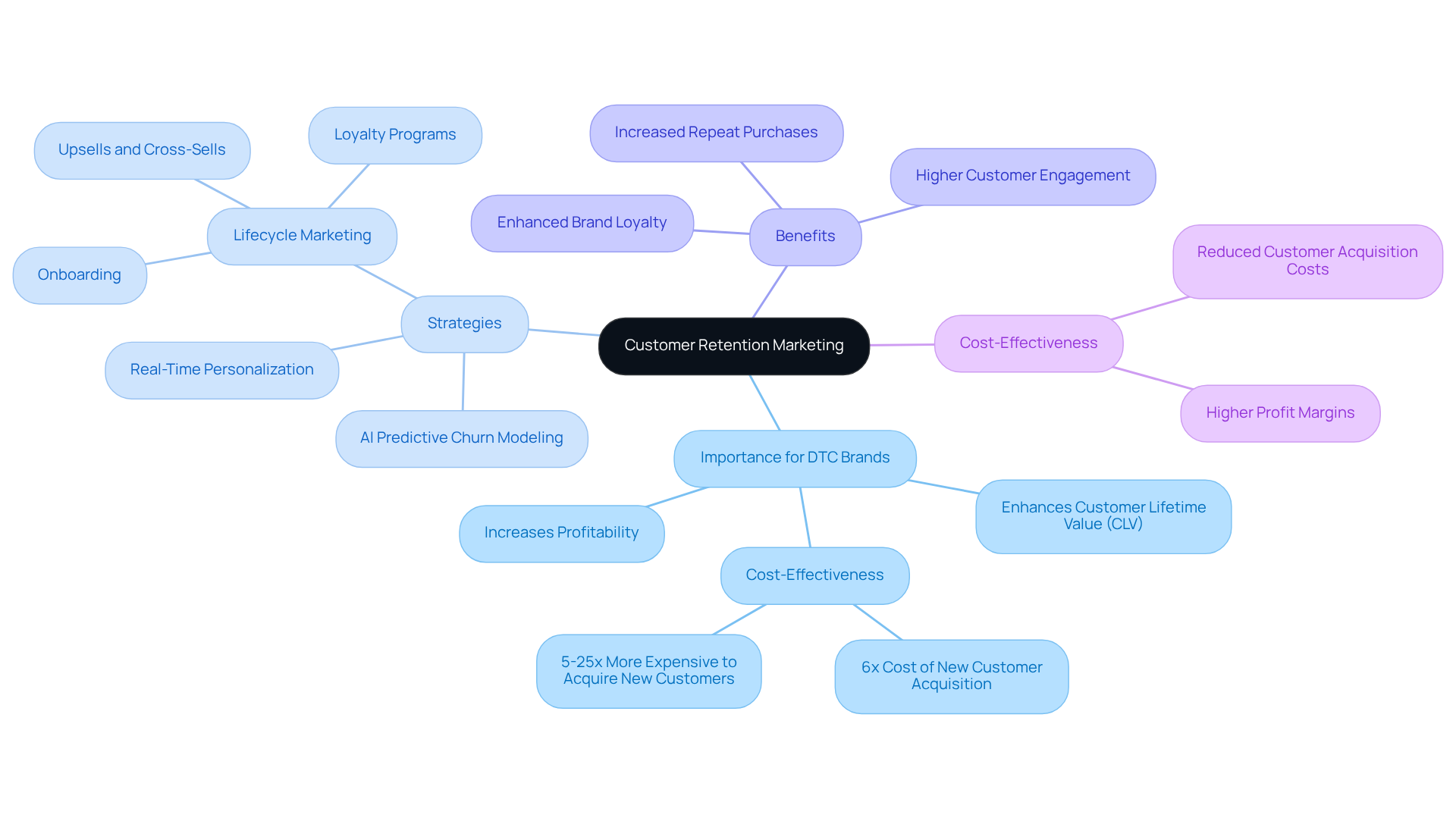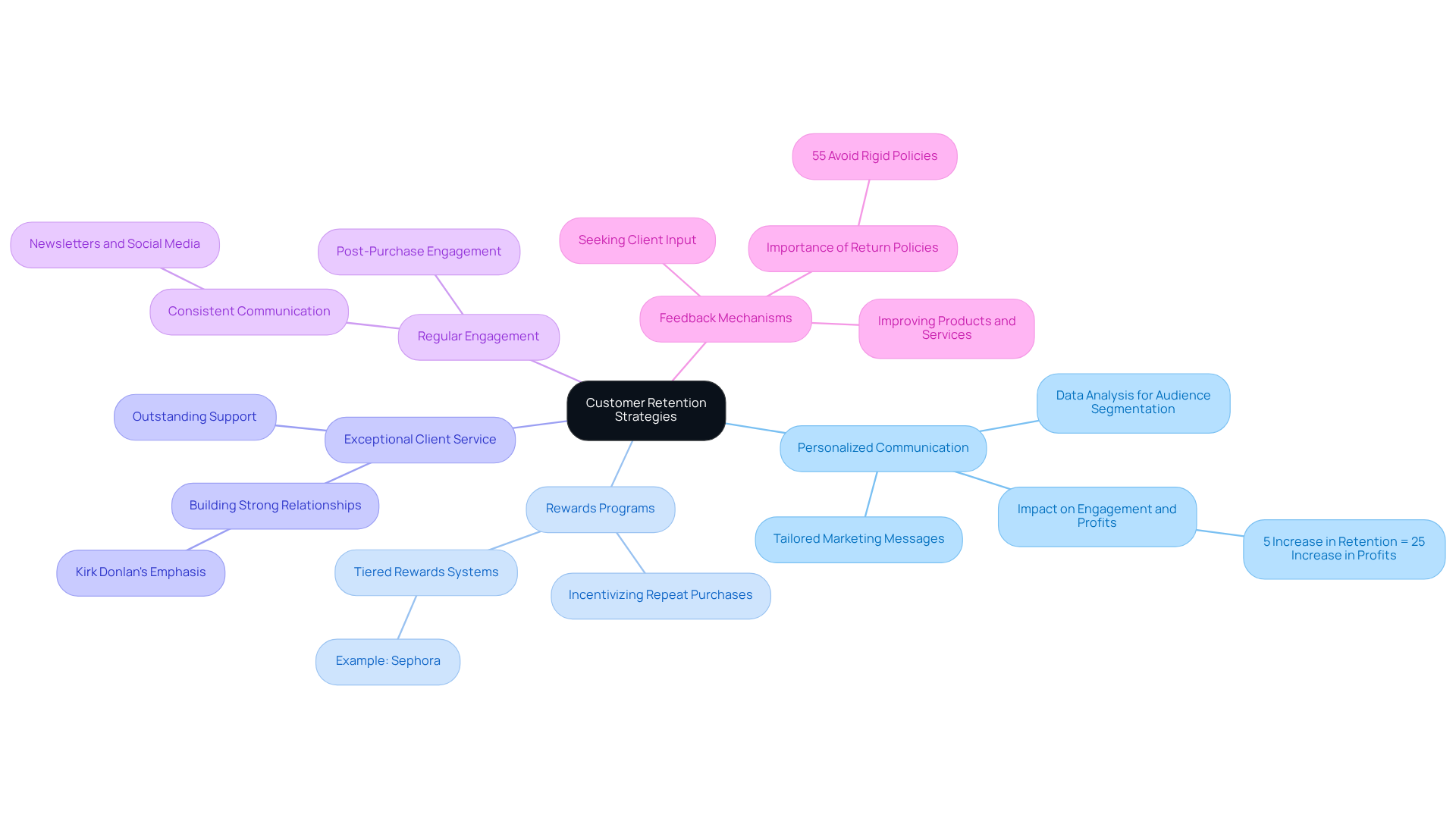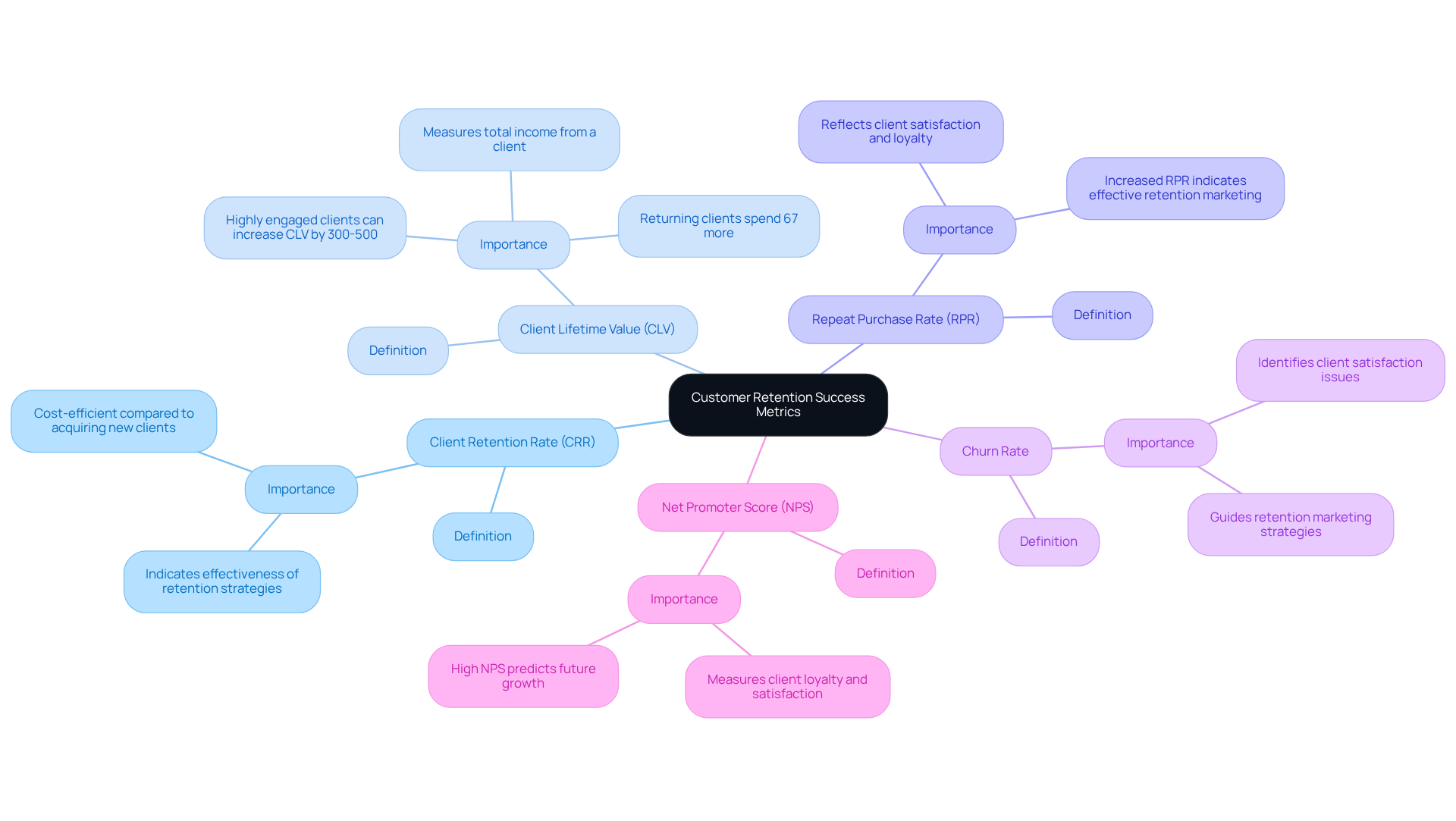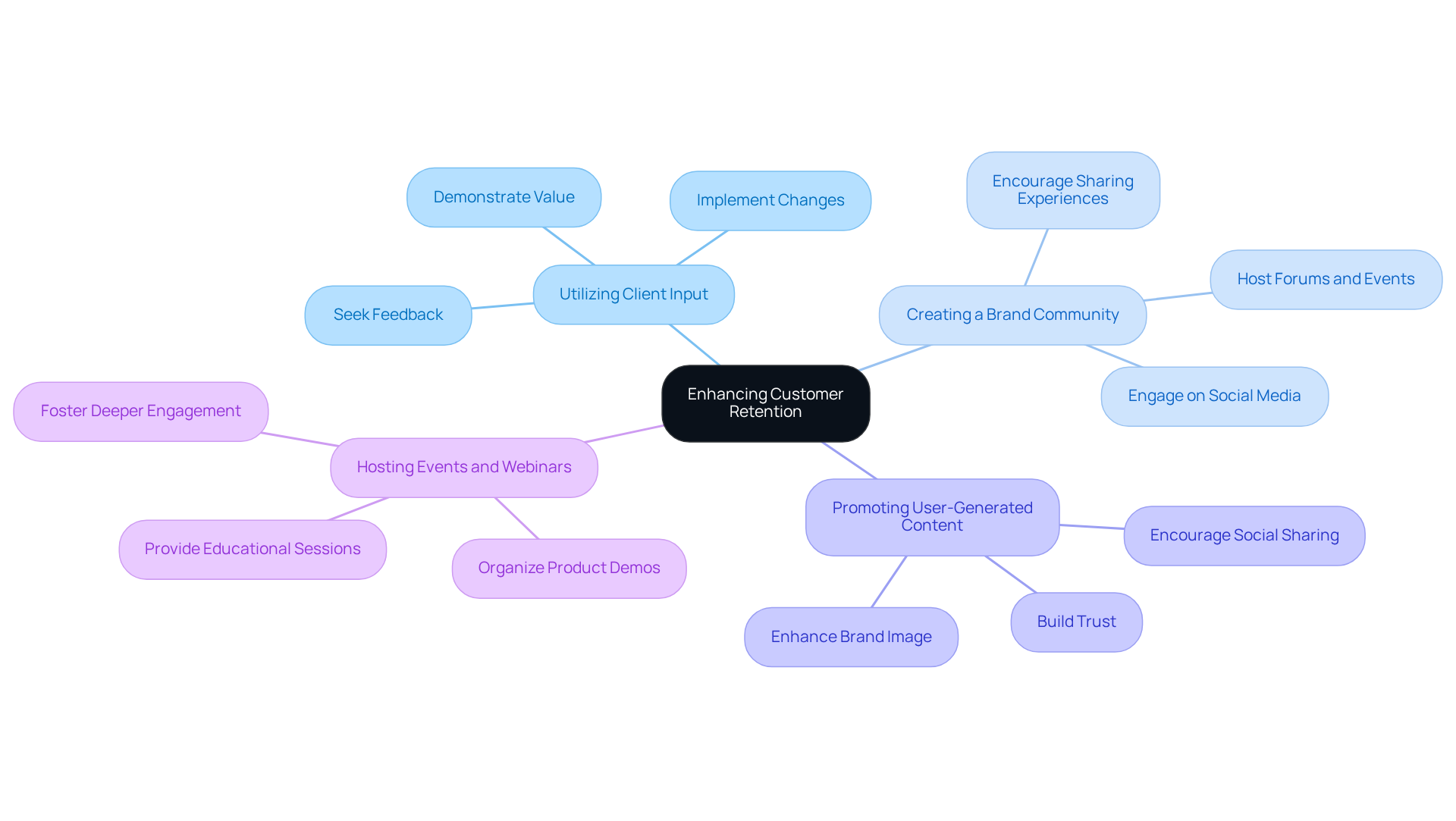
Overview
Customer retention marketing is crucial for direct-to-consumer (DTC) brands, as it centers on strategies designed to keep existing customers engaged. This approach not only boosts profitability but also enhances customer lifetime value.
Retaining customers is significantly more cost-effective than acquiring new ones; thus, DTC brands must prioritize retention strategies. Successful tactics include:
- Personalized communication
- Rewards programs
- Exceptional client service
These elements not only enhance customer loyalty but also drive repeat purchases, ultimately reinforcing the brand's market position.
Introduction
Customer retention marketing has emerged as a pivotal strategy for direct-to-consumer (DTC) brands, particularly in an environment where acquiring new customers can be significantly more costly. By concentrating on retaining existing clients, brands not only enhance their profitability but also maximize customer lifetime value. Studies indicate that even a slight increase in loyalty can yield substantial profit growth.
However, amidst rising competition and evolving consumer expectations, how can DTC brands effectively implement retention strategies that resonate with their audience? This article delves into proven tactics and best practices that empower brands to foster lasting relationships with their customers, ensuring sustained engagement and loyalty.
Define Customer Retention Marketing and Its Importance for DTC Brands
Customer retention marketing encompasses the strategies and tactics that companies employ to keep their existing clientele engaged and encourage repeat purchases. For direct-to-consumer (DTC) brands, this focus is crucial, particularly in light of escalating client acquisition costs. Retaining clients not only bolsters profitability but also significantly enhances (CLV). Indeed, studies reveal that even a modest 5% increase in client loyalty can lead to profit surges ranging from 25% to 95%.
Moreover, attracting a new client incurs more than six times the cost of retaining an existing one, underscoring the cost-effectiveness of loyalty strategies. Consequently, DTC companies must prioritize customer retention marketing to build enduring relationships with their clients, fostering heightened loyalty and support.
By implementing effective customer retention marketing strategies, such as utilizing AI for predictive churn modeling and real-time personalization, companies can secure a sustainable competitive edge in an increasingly crowded marketplace.
Parah Group, as a specialized CRO agency, champions sustainable growth and profitability through tailored strategies that enhance client engagement and loyalty. Our transformational case studies illustrate how we have successfully executed innovative strategies in customer retention marketing—optimizing product pricing and introducing post-purchase upsells—that not only drive revenue growth but also substantially improve retention rates for DTC companies.

Implement Effective Customer Retention Strategies: Best Practices for DTC Brands
To effectively retain customers, DTC brands must embrace the following best practices:
- Personalized Communication: Tailoring marketing messages to align with consumer behavior and preferences is essential. By employing data analysis for audience segmentation, brands can dispatch tailored emails and offers that resonate with personal interests, significantly boosting engagement and commitment. Research indicates that customer retention marketing, which enhances client retention rates by just 5%, can lead to an impressive increase of over 25% in profits, underscoring the financial impact of effective retention strategies.
- Rewards Programs: Implementing rewards programs that incentivize repeat purchases is crucial. Successful brands like Sephora have effectively utilized tiered rewards systems to promote ongoing engagement, motivating clients to return for exclusive benefits and experiences. This practical application illustrates the power of in fostering client loyalty.
- Exceptional Client Service: Providing outstanding support to resolve issues swiftly and effectively is paramount. A positive support experience significantly enhances satisfaction and loyalty, making clients feel valued and appreciated. As Kirk Donlan emphasizes, maintaining a strong and intentional relationship with clients is vital for retention.
- Regular Engagement: Consistent communication with clients through newsletters, social media, and personalized follow-ups is essential. This strategy not only maintains awareness but also promotes return visits, thereby supporting customer retention marketing and strengthening the connection between the company and its clients. Engaging with clients post-purchase can nurture brand devotion and community.
- Feedback Mechanisms: Actively seeking input from clients through surveys and reviews is necessary. Leveraging this information to improve products and services demonstrates to clients that their viewpoints are valued, fostering a sense of community and loyalty. Establishing efficient feedback systems can significantly enhance client satisfaction and loyalty. Furthermore, clear return policies are critical; 55% of shoppers avoid companies with rigid return policies, highlighting the importance of transparency in consumer interactions.

Measure Customer Retention Success: Key Metrics and KPIs for DTC Brands
To effectively measure customer retention, DTC brands must focus on key metrics that drive success:
- Client Retention Rate (CRR): This metric signifies the percentage of clients who continue to engage with the company over a specific duration. A higher CRR is indicative of effective customer retention marketing strategies, which are vital for long-term profitability. Maintaining current clients is considerably more cost-efficient than acquiring new ones.
- Client Lifetime Value (CLV): Understanding the total income generated by an individual during their relationship with the company is crucial for evaluating the long-term worth of loyalty initiatives. For DTC brands, highly engaged clients can enhance their lifetime value by 300-500%, underscoring the importance of nurturing these relationships. Moreover, demonstrates that returning clients spend 67% more than new patrons, highlighting the financial benefits of prioritizing loyalty.
- Repeat Purchase Rate (RPR): This metric assesses the percentage of clients who make multiple purchases. An increased RPR signifies effective customer retention marketing efforts and reflects client satisfaction and allegiance—both essential for sustaining revenue growth. Loyal clients should receive special benefits to further strengthen their commitment.
- Churn Rate: The churn rate indicates the proportion of clients who stop engaging with the company. Monitoring this metric helps identify potential issues in client satisfaction and enables companies to use customer retention marketing strategies to take prompt action to enhance retention. However, it is crucial to balance metric tracking with a focus on user experience to avoid common pitfalls.
- Net Promoter Score (NPS): NPS measures client loyalty and satisfaction by asking how likely clients are to recommend the company. A high NPS indicates strong client loyalty and can serve as a predictor of future growth, as devoted patrons often generate word-of-mouth recommendations—trusted by 92% of consumers. Fostering emotional connections is vital for long-term success.
By closely monitoring these metrics and prioritizing client experience, DTC companies can refine their customer retention marketing strategies, enhance consumer loyalty, and ultimately drive sustainable growth.

Leverage Customer Feedback and Build Community to Enhance Retention
To enhance customer retention, DTC brands must prioritize the following strategies:
- Utilizing Client Input: Actively seeking and evaluating is essential to understanding their needs and preferences. By implementing changes based on this feedback, brands can demonstrate to clients that their opinions are valued, which is crucial for effective customer retention marketing and fostering loyalty.
- Creating a Brand Community: Building a sense of community among clients through social media groups, forums, or events is crucial. Engaging clients in conversations and allowing them to share experiences significantly strengthens their connection to the brand.
- Promoting [User-Generated Content](https://antavo.com/blog/customer-loyalty-statistics): Encouraging clients to share their experiences with the brand on social media not only enhances the brand image but also cultivates trust among potential clients. This organic promotion is invaluable in today’s digital landscape.
- Hosting Events and Webinars: Organizing events or webinars that provide value to clients—such as product demonstrations or educational sessions—creates opportunities for deeper engagement. These interactions are vital for strengthening customer relationships and enhancing brand loyalty through effective customer retention marketing.

Conclusion
Customer retention marketing stands as a pivotal focus for direct-to-consumer (DTC) brands intent on nurturing enduring relationships with their clients. By emphasizing the retention of existing customers, brands can markedly enhance profitability and customer lifetime value, all while minimizing the expenses tied to acquiring new clients. The significance of this strategy is profound; even a modest enhancement in customer loyalty can yield considerable financial rewards.
This article elucidates several effective practices for bolstering customer retention, such as:
- Personalized communication
- Rewards programs
- Exceptional client service
- Regular engagement
- Robust feedback mechanisms
Each strategy is instrumental in fostering customer loyalty and satisfaction, ultimately cultivating a more devoted client base. Furthermore, measuring success through key metrics like client retention rate, customer lifetime value, and net promoter score empowers brands to refine their methodologies and ensure they effectively meet customer needs.
In today's competitive landscape, the capacity to retain customers is not merely advantageous but essential for sustainable growth. DTC brands must proactively implement these strategies and consistently seek feedback to adapt and excel. By embracing customer retention marketing, brands can forge stronger connections, enhance loyalty, and solidify their standing in the marketplace for years to come.
Frequently Asked Questions
What is customer retention marketing?
Customer retention marketing refers to the strategies and tactics that companies use to keep their existing customers engaged and encourage repeat purchases.
Why is customer retention marketing important for direct-to-consumer (DTC) brands?
Customer retention marketing is crucial for DTC brands because it helps reduce client acquisition costs, bolsters profitability, and significantly enhances customer lifetime value (CLV).
How does an increase in client loyalty impact profitability?
Studies show that even a modest 5% increase in client loyalty can lead to profit increases ranging from 25% to 95%.
What are the costs associated with acquiring new clients compared to retaining existing ones?
Attracting a new client costs more than six times the amount of retaining an existing one, highlighting the cost-effectiveness of loyalty strategies.
What strategies can DTC companies implement for effective customer retention?
DTC companies can utilize strategies such as AI for predictive churn modeling and real-time personalization to enhance customer retention.
How does Parah Group contribute to customer retention marketing for DTC brands?
Parah Group, as a specialized CRO agency, promotes sustainable growth and profitability through tailored strategies that enhance client engagement and loyalty, showcasing successful case studies in customer retention marketing.
What specific strategies has Parah Group implemented to improve retention rates?
Parah Group has optimized product pricing and introduced post-purchase upsells as strategies to drive revenue growth and improve retention rates for DTC companies.
FAQs











